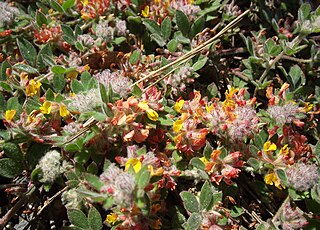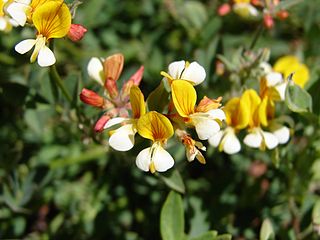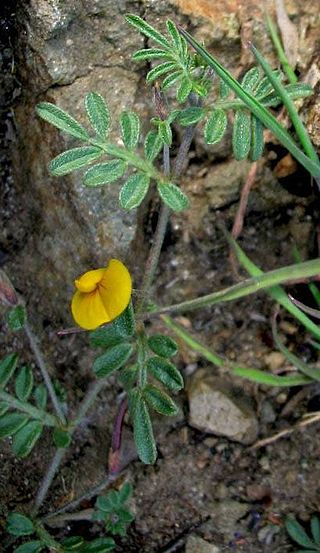
Lotus, a latinization of Greek lōtos, is a genus of flowering plants that includes most bird's-foot trefoils and deervetches and contains many dozens of species distributed in the eastern hemisphere, including Africa, Europe, western, southern, and eastern Asia, and Australia and New Guinea. Depending on the taxonomic authority, roughly between 70 and 150 are accepted. Lotus is a genus of legumes and its members are adapted to a wide range of habitats, from coastal environments to high elevations.

Hosackia rosea, synonym Lotus aboriginus, is a species of legume native to North America. It is known by the common names rosy bird's-foot trefoil and thicket trefoil. It grows in mountains and canyons, often in moist areas. It is a perennial herb lined with leaves each made up of pairs of oval leaflike leaflets 1 to 3 cm long. The inflorescence is a spray of six to 10 white or pink flowers each about 1 cm long. The flower is somewhat tubular, encased at the base in a calyx of sepals and lobed at the mouth. The fruit is a hairless elongated legume pod 3–5 cm long.

Acmispon cytisoides, synonyms Lotus benthamii and Syrmatium cytisoides, is a species of legume native to California. It is known by the common names Bentham's broom and Bentham's deerweed. It is endemic to central California, where it occurs along the Central Coast and into the coastal mountain ranges. It grows in oceanside habitat and inland on slopes and in canyons. It is a mat-forming or spreading perennial herb lined with leaves each made up of a few oval leaflike leaflets up to 12 mm long. The inflorescence bears up to 10 dull pinkish dark-veined flowers, each just under 1 cm long.

Acmispon dendroideus, synonym Syrmatium veatchii, is a species of legume native to California. It is known by the common name island broom. It is endemic to the Channel Islands of California, where it grows on coastal bluffs and cliffs. It is a spreading perennial herb or erect shrub approaching 2 meters in height. It is hairless to hairy and gray-green in color. The branches lined with leaves each made up of a few oval leaflike leaflets up to 1.5 centimeters long each. The inflorescence bears up to 10 yellow pealike flowers, each roughly a centimeter long and fading red as they age.

Hosackia gracilis, synonym Lotus formosissimus, is a species of legume native to western North America from British Columbia through Washington and Oregon to California. It was first described by George Bentham. It is known by the common names harlequin lotus and seaside bird's-foot trefoil. It grows in moist spots in the coastal mountains and down to the oceanside bluffs. It is a perennial herb growing upright or spreading to about 0.5 m in maximum length. It is lined with leaves each made up of a few oppositely arranged oval leaflets up to 2 cm long. The inflorescence is made up of several pealike flowers each 1 to 2 cm long. The flower has a bright yellow banner, or upper petal, and bright pink or white lower petals. The fruit is a legume pod 2 to 3 cm long.

Acmispon grandiflorus, synonym Lotus grandiflorus, is a species of legume native to western North America. It is known by the common name chaparral bird's-foot trefoil.

Acmispon micranthus is a species of legume native to California and northwestern Mexico. It is known by the common name San Diego bird's-foot trefoil. It is found in the coastal mountain ranges of California and Baja California, where it grows in various types of scrub and canyon habitat. It is an annual herb taking a spreading or upright form. It is lined with leaves each made up of oval leaflets each about a centimeter long. The inflorescence is a small bunch of red and yellow flowers. Each flower is in a tubular calyx of sepals and is only a few millimeters long. The fruit is a narrow, bent legume pod up to 1.5 centimeters long, including the hooked beak at the tip.
Acmispon haydonii, synonyms Lotus haydonii and Syrmatium haydonii, is a species of legume native to California It is known by the common names pygmy lotus, rock bird's-foot trefoil and Haydon's lotus.

Acmispon heermannii is a species of flowering plant in the family Fabaceae known by the common names Heermann's bird's-foot trefoil and Heermann's lotus. It is native to the coastal plains, canyons, and mountains of California and Baja California, where it is known from several types of oceanside and inland habitat. It is a mat-forming perennial herb spreading straight stems along the ground. It is lined with leaves made up of several hairy oval leaflets. The inflorescence is a cluster of 3 to 8 flowers each up to about a centimeter long. The petals are yellow, often with dark lobes. The fruit is a curved, beaked legume pod.
Acmispon junceus, synonyms Lotus junceus and Syrmatium junceum, is a species of legume native to California. It is known by the common names rush broom and rush deervetch. It is endemic to California, where it is known from the northern and central coast and the coastal mountain ranges. It can be found from beaches inland to serpentine slopes and chaparral. It is a hairy, prostrate or spreading perennial herb lined with leaves each made up of small oval leaflets. The inflorescence bears up 8 yellow pealike flowers each up to about a centimeter long. The fruit is a small beaked legume pod.

Acmispon prostratus, synonyms Lotus nuttallianus and Syrmatium prostratum, is a species of legume native to California and northwestern Mexico. It is known by the common names beach lotus, Nuttall's lotus, and wire bird's-foot trefoil. It is native to Baja California and just into San Diego County, California, where it is a resident of coastal habitats, such as beaches and bluffs.

Hosackia oblongifolia, synonym Lotus oblongifolius, is a species of legume native to western North America from Oregon to northern Mexico. It is known by the common name streambank bird's-foot trefoil or meadow lotus. It grows in moist to wet areas in several types of habitat. It is a spreading or upright perennial herb lined with leaves each made up of 3 elongated oval leaflets each up to 2.5 centimeters long. The inflorescence bears several yellow and white flowers between 1 and 2 centimeters long. The fruit is very elongated, reaching up to 5 centimeters in length but just a few millimeters in width.
Hosackia pinnata, synonym Lotus pinnatus, is a species of legume native to western North America from British Columbia to California. It is known by the common names meadow bird's-foot trefoil and bog bird's-foot trefoil. Its distribution extends into British Columbia in just a few rare occurrences near Nanaimo. It grows in moist to wet habitat, such as bogs and spring meadows. It is a hairless perennial herb lined with leaves each made up of green oval leaflets each 1 to 2.5 centimeters in length. The inflorescence is an array of up to 10 pealike flowers between 1 and 2 centimeters long. Each flower has a bright yellow banner, or upper petal, and white lower petals. The fruit is a slender, elongated legume pod up to 5 centimeters long but just a few millimeters wide.

Acmispon maritimus, synonym Lotus salsuginosus, is a species of legume native to Arizona, California and northwestern Mexico. It is known by the common name coastal bird's-foot trefoil. It grows in many types of mountain, desert, and scrub habitat, not necessarily near the coast. It is an annual herb quite variable in morphology, from petite to bushy, hairless to roughly hairy, and prostrate to erect in form. The slender stems are lined with leaves each made up of pairs of leaflets variable in shape and size. The inflorescence is a small array of 1 to 4 yellow flowers, each up to a centimeter long or so. The elongated flower corolla emerges from a tubular calyx of sepals. The fruit is a legume pod up to 3 centimeters long. Laboratory studies have shown this species, which occurs in wildfire-prone habitat such as chaparral, to have an increased rate of seed germination after exposure to heat.

Hosackia stipularis, synonym Lotus stipularis, is a species of legume endemic to California. It is known by the common name balsam bird's-foot trefoil. It is found in most of the northern and central coastal and inland mountain ranges and foothills. It can be found in many types of habitat, including forest, chaparral, and disturbed areas. This is a mostly erect perennial herb with a leafy, often hairy and glandular form. Its slender branches are lined with leaves each made of several leaflets up to 2 centimeters long. The leaves sometimes have prominent stipules. The inflorescence is a compact array of up to 9 pink flowers. Each flower is elongated, the corolla borne in a tubular calyx of sepals, and the entire unit may exceed a centimeter long. The fruit is a legume pod 2 or 3 centimeters long containing several beanlike seeds.

Malacothrix incana is an uncommon species of flowering plant in the family Asteraceae known by the common name dunedelion. This species is a mounding shrub with wooly leaves. It is endemic to California, where it grows only in sand dunes on the beaches of the Channel Islands and isolated spots along the mainland coastline in San Luis Obispo and Santa Barbara Counties. Malacothrix incana was first collected in San Diego, far south of its present range, but the plant is now extirpated from there.

Acmispon strigosus, synonyms Lotus strigosus and Ottleya strigosa, is a flowering plant in the pea family (Fabaceae), native to the southwestern United States and northern Mexico. It is known as stiff-haired lotus or strigose bird's-foot trefoil.
Hosackia yollabolliensis is a species of flowering plant in the family Fabaceae, native to California. It was first described, as Lotus yollabolliensis, by Philip A. Munz in 1955. It was transferred to Hosackia by D.D. Sokoloff in 2000. It is also known as the Yolla Bolly Mountains bird's-foot trefoil.

Syrmatium was a formerly accepted genus of flowering plants in the family Fabaceae (legumes), native to the southwestern United States. As of February 2021, it was considered a synonym of Acmispon by Plants of the World Online, and only Acmispon was recognized by the Jepson eFlora.

Acmispon decumbens is a species of flowering plant in the family Fabaceae, native to the western United States and north-western Mexico. It was first described by George Bentham in 1836 as Hosackia decumbens.














